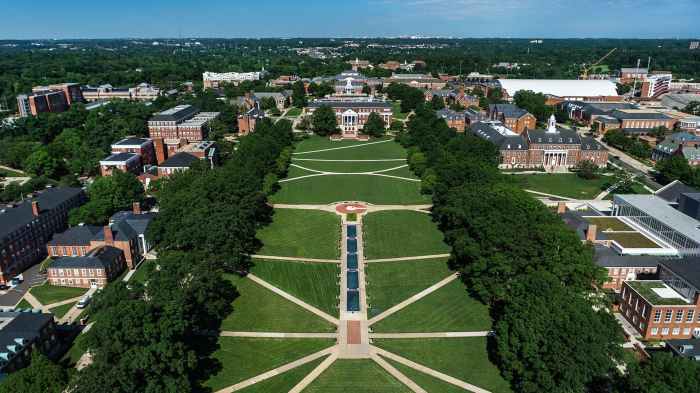Embark on a journey to unveil the intricacies of University of Maryland’s in-state tuition. Dive into a world of costs, factors, aid, comparisons, and future trends that shape the financial landscape of higher education at this esteemed institution.
Prepare to unravel the mysteries of tuition fees, explore the forces that drive them, and discover the avenues of financial assistance that can pave the way for your academic aspirations.
In-State Tuition Costs
The University of Maryland offers competitive in-state tuition rates for undergraduate and graduate programs. These costs cover the essential expenses associated with attending the university, such as instruction, facilities, and student services.
In addition to tuition, students may also incur additional fees and expenses, such as:
Undergraduate Tuition
- Full-time tuition: $10,614 per year
- Part-time tuition: $442 per credit hour
Graduate Tuition
- Full-time tuition: $13,170 per year
- Part-time tuition: $549 per credit hour
Additional Fees and Expenses
- Student fees: $1,452 per year
- Health insurance: $2,160 per year
- Housing and dining: $12,000-$15,000 per year
- Books and supplies: $1,000-$2,000 per year
- Transportation: $1,000-$2,000 per year
Factors Influencing Tuition Rates

The University of Maryland’s in-state tuition rates are determined by a complex interplay of factors, including state funding, enrollment trends, and economic conditions. Understanding these factors is crucial for prospective students and policymakers alike.
One of the most significant factors influencing tuition rates is state funding. Public universities like the University of Maryland rely heavily on state appropriations to cover operating costs, including faculty salaries, research programs, and student services. When state funding is reduced, universities may be forced to raise tuition to make up the shortfall.
Enrollment Trends
Enrollment trends also play a role in tuition rates. As enrollment increases, universities may be able to spread their fixed costs over a larger number of students, resulting in lower tuition rates per student. Conversely, declining enrollment can lead to higher tuition rates as universities seek to maintain their revenue streams.
Economic Conditions
Economic conditions can also impact tuition rates. During economic downturns, state governments may face budget constraints that lead to reduced funding for higher education. This, in turn, can lead to tuition increases as universities seek to offset lost revenue.
Financial Aid and Scholarships
In-state students at the University of Maryland have access to various financial aid and scholarship opportunities to support their academic pursuits. These include need-based grants, merit-based scholarships, and work-study programs.
Eligibility for financial aid is determined by factors such as family income, assets, and academic performance. Students must complete the Free Application for Federal Student Aid (FAFSA) to determine their eligibility for federal and state aid.
Types of Financial Assistance
- Grants: Grants are financial aid that does not need to be repaid. They are typically awarded to students with financial need.
- Scholarships: Scholarships are financial aid that is awarded to students based on merit, such as academic achievement, leadership, or athletic ability.
- Work-Study: Work-study programs allow students to earn money to help pay for their education. Students work part-time on campus or in the community.
The University of Maryland offers a variety of scholarships specifically for in-state students. These scholarships range from small awards to full-tuition scholarships.
Students should explore all available financial aid and scholarship opportunities to maximize their financial support and reduce the cost of their education.
Comparison with Other Universities

The University of Maryland’s in-state tuition rates are comparable to those of other universities in the region and nationally. Let’s explore some key comparisons:
Public Universities in the Mid-Atlantic Region
Within the Mid-Atlantic region, the University of Maryland’s in-state tuition rates are generally higher than those of state universities in neighboring states such as Pennsylvania, Delaware, and West Virginia. However, they are lower than the rates at prestigious institutions like the University of Virginia and the University of North Carolina at Chapel Hill.
Public Universities Nationally
On a national scale, the University of Maryland’s in-state tuition rates fall within the average range for public universities. They are lower than the rates at elite public universities such as the University of California, Berkeley, and the University of Michigan, but higher than those at less selective public universities in the Midwest and South.
Factors Influencing Differences
The differences in tuition rates between the University of Maryland and other universities can be attributed to several factors, including:
- State funding: The level of state funding for higher education varies significantly across the country, which impacts the cost of tuition.
- University reputation and selectivity: Universities with higher reputations and selectivity tend to have higher tuition rates.
- Program offerings and facilities: Universities with a wider range of academic programs and state-of-the-art facilities typically have higher tuition rates to cover the associated costs.
- Cost of living: The cost of living in the university’s location also plays a role in determining tuition rates.
Future Trends in Tuition
Predicting the future of in-state tuition rates at the University of Maryland is a complex task, influenced by a myriad of factors. This section will analyze potential trends and discuss the key elements that could shape future tuition increases or decreases.
State Funding
State funding is a critical factor in determining tuition rates. Historically, public universities have relied heavily on state appropriations to offset operating costs and keep tuition affordable. However, in recent years, state funding for higher education has been declining, putting pressure on universities to raise tuition to make up for the shortfall.
Enrollment Projections
Enrollment projections also play a role in tuition rates. If enrollment increases, the university may be able to spread its fixed costs over a larger number of students, potentially leading to lower tuition increases. Conversely, if enrollment declines, the university may need to raise tuition to maintain its revenue stream.
Economic Conditions
The overall economic climate can also influence tuition rates. During periods of economic growth, universities may be more likely to raise tuition as students and families have more disposable income. Conversely, during economic downturns, universities may be more hesitant to raise tuition as students and families may be struggling financially.
Key Questions Answered
What is the average in-state tuition at the University of Maryland?
For undergraduate programs, the average in-state tuition is around $10,000 per year. For graduate programs, the average in-state tuition is around $12,000 per year.
What are some of the factors that influence in-state tuition rates?
Factors that influence in-state tuition rates include state funding, enrollment, and economic conditions.
What types of financial aid and scholarships are available to in-state students?
In-state students may be eligible for a variety of financial aid and scholarships, including grants, scholarships, and loans.
How does the University of Maryland’s in-state tuition compare to other universities?
The University of Maryland’s in-state tuition is generally comparable to other public universities in the region.
What are some potential future trends in in-state tuition rates at the University of Maryland?
Potential future trends in in-state tuition rates include increases due to rising costs and decreases due to increased state funding.





